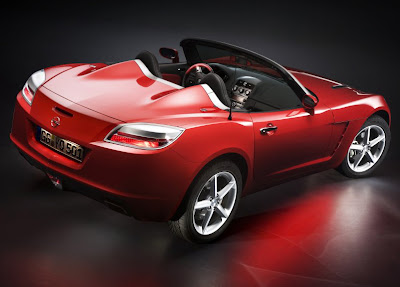Innovative Production Processes
- Rigid vehicle structure with hydroformed side members à la Corvette
- Production according to “GM Global Manufacturing System”
The Opel GT’s roadster architecture, which it shares with its successful American sister models Pontiac Solstice and Saturn Sky, was designed from the beginning to meet the special demands of a sporty two-seater of this classic genre. The chassis is assembled using a number of different fabrication processes and assembly methods: Hydroformed steel frame tubes - with their high strength-to-weight ratio - and conventional stampings are joined using spot welding, MIG welding and adhesive bonding to produce the extremely rigid chassis structure needed in a convertible sports car.
The Opel GT is built at the Wilmington/Delaware plant in the USA according to the quality focused “GM Global Manufacturing System” (GM GMS). Implemented worldwide, the system is based on five key concepts: Built-in-Quality, Standardization, Continuous Improvement, Short Lead Time and People Involvement including shared responsibility for quality management.
The hydroformed tube structure, which runs from the front bumper, through the left and right-hand frame tubes all the way to the rear bumper, provides the vehicle with an extremely strong foundation. The only other car that uses this kind of complete hydroformed frame is the Chevrolet Corvette – for the same reason: The high strength-to-weight ratio of a hydroformed frame greatly benefits a powerful sports car.
Sheet hydroforming uses water pressure to help create the vehicle’s skin. The process is slower and more precise than traditional body stamping and offers the advantage of providing a much deeper “draw,” which enables the designers to use a greater creative freedom. Hydroforming alone made possible the Opel GT’s large, curvaceous clamshell hood, doors and rear quarter panel. Conventional stamping processes could not yield the same results.
Composite construction similar to Corvette
In the body shop, the underbody - including a large, enclosed central tunnel - is welded to the frame tubes. Floor panels are spot-welded above the corrugated sections to provide a flat passenger footwell area for both seats in a composite construction process similar to the one used on the Corvette. Unique assembly methods are employed during production to achieve the highest possible rigidity, such as adhesive bonding and MIG welding technology. Metal Inert Gas (MIG) welding technology is a special electric arc welding process whereby the welding point is sprayed with a protective gas. MIG welding is employed on the Opel GT for the brackets and other chassis and body structures. Accessibility was the key here and was partly necessitated by the use of the hydroformed frame tubes, whose box sections do not allow for access to the inside of the tube.
The front dash structure and windshield frame - created from molded steel components that are spot welded together as a complete unit - are built up separately from the rest of the chassis. Although they have no supporting function, they do increase torsional rigidity. After painting, the unit is fitted with the instrument panel, steering controls, pedals and other related components. This dash/windshield sub-assembly is mated to the chassis during the vehicle’s general assembly process when it is lowered over the chassis hinge pillars and bonded in place using industrial adhesive - a process which is also used in modern aircraft construction - applied at the lower edge. Locating bolts on the hinge pillars hold the assembly in place during the curing process. Using similar modular designs, the upper rear partition well and luggage compartment well are pre-assembled from fiberglass-reinforced composite material.
In the event of damage to a car, technical adhesive bonding can be used for a range of low-cost repair procedures. The new Opel GT is a repair-friendly representative of its class, and is favorably classified by insurers despite its high level of driving performance. The body’s modular design, clever arrangement of components (a radiator situated far behind the large impact limiter, for example), the possibility of sectional repairs and the repairable hydroformed steel frame all contribute to the car’s favorable insurance rating.
Complex processes for exact finishes
All exterior body components are painted separately from the chassis structure prior to assembly. The parts are lacquered in groups on a “painting buck” to ensure color match. This off-line painting process makes possible the special accent-color body parts, such as the silver-colored windshield frame and tulip panel behind the driver and passenger seat headrests Wilmington assembly's body shop consists primarily of manual operations. Many of the around 1800 employees are well-trained, experienced specialists in precise manual body construction. Apart from a few robot stations, the roadster is completely produced by complex manual workmanship.
1 | 2 | 3 | 4 | 5 | 6 |






Related entries:
Steinmetz GT debut in Essen

No comments:
Post a Comment